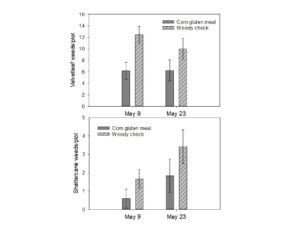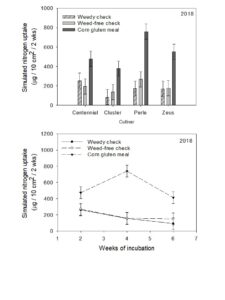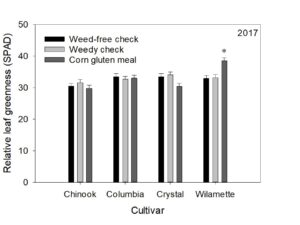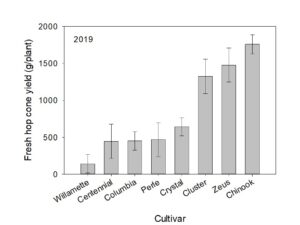Final report for GNC17-237
Project Information
Research
We conducted a total of four field trials in an experimental hop yard in 2017, 2018, and 2019 to determine the effect of corn gluten meal (CGM) on weed emergence, soil mineral nitrogen availability, leaf greenness, and hop yield. However, not all data was collected in each year. In 2017 and 2018, trials were designed to specifically test for effects of CGM on weed emergence and leaf greenness. In 2018, we included data collection for soil mineral nitrogen availability. In 2019, two trials were conducted to test for immediate (1st year) and residual (2nd year) effects of CGM on hop yield.
The experimental design to measure weed emergence, soil mineral nitrogen availability, leaf greenness, and 1st year yield response was a randomized complete block with three replications. Each experimental unit was a single hop plant in a previously established yard.
Treatments:
- CGM = corn gluten meal (applied at rate 250 lbs N/acre, based on a 1st season mineralization estimate of 50% to achieve 125 lbs PAN/acre)
- WF = weed free control + urea fertilizer (125 lbs N/acre)
- WD = weedy control + urea fertilizer (125 lbs N/acre)
General methods:
- Each experimental unit was defined as the area immediately surrounding one plant (3 x 1.5 ft), and a buffer plant between experimental units was included to prevent crossover of corn gluten meal or synthetic fertilizer on adjacent plants.
- We planted 50 velvetleaf (Abutilon theophrasti) seed and 50 shattercane (Sorghum bicolor) seed per experimental unit to assess effects of CGM on weed emergence of a model broadleaf and grass weed species in Nebraska.
- We then broadcast weed seeds in each plot and covered with a uniform volume of top soil.
- CGM was applied within 24 hours of planting weed seeds to leverage potential pre-emergent herbicidal effects of CGM.
- If it did not rain with 48 hours of CGM application, plots were watered by hand to initiate weed seed germination.
- In 2018, we installed Plant Root Simulator (PRS) probes (ion exchange resin stakes) in all plots within 48 hours of applying CGM. Two sets of probes (4 probes in total) per plot were evenly distributed throughout the area (two on each side of the plant). Probes were buried for 2 weeks, removed, and then replaced by a new set of probes within the same hole for subsequent 2 week burial periods for a total of 6 weeks (three incubation intervals). Probes were cleaned within 24 hours of removal from the field, and shipped to WesternAg for extraction of mineral N and analysis.
- Other than application of CGM, hops were otherwise managed using best management practices for Nebraska (e.g., irrigation, pest scouting and management).
- Weed emergence was recorded in all plots every two weeks.
- Leaf chlorophyll content was estimated via leaf greenness as measured by SPAD every two weeks.
In 2019, experimental design of the two concurrent hop yield trials were both randomized complete block with three replications. There are a total of eight cultivars in this hop yard. Four cultivars were used for the 1st year response yield trial (immediate), and the other four were used in the 2nd year response yield trial (residual). For the 1st year response trial, experimental treatments and hop yard management were identical to 2017 and 2018 trials. For the 2nd year response trial, we tracked plants from the 2018 trial that had received CGM and compared those to plants that received either no urea N fertilizer or 125 lbs N/acre via urea. However, no additional CGM was applied in 2019 in the 2nd year response trial (in order to test for possibility that residual N from 2018 application may contribute to yield in 2019).
Weed suppression
- Corn gluten meal (CGM) reduced velvetleaf emergence by 37% to 50%, but suppression declined slightly over time
- CGM reduced shattercane emergence by 46% to 65%, and weed suppression increased slightly over time
Soil mineral nitrogen availability (PRS probe data)
- CGM increased total mineral soil N by more than 2-fold compared to the weedy and weed-free checks that received 50 lbs N/acre as urea in two split applications (one of which occurred during the 6-week sample)
- Increases in total mineral soil N were influenced by cultivar, likely due to differences in growth rate and N uptake among cultivars
- Ammonium (NH4+) availability in soil was significantly increased during the first 4 weeks following CGM application. We hypothesize that the elevated ammonium contributed to suppression of velvetleaf and shattercane emergence and seedling development.
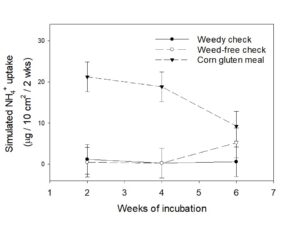
Leaf greenness (chlorophyll content)
- Despite large increases in mineral soil N from CGM compared to urea, there were no changes in leaf greenness among cultivars in 2018 and only among treatments in 1 of 4 cultivars in 2017. This suggests that N levels applied via urea were sufficient for hops in eastern Nebraska.
Hop yield
- Consistent with leaf greenness data, there was no effect of CGM on hop yield in the same or subsequent year following application (despite elevated soil mineral N as measured by PRS probes).
- However, we did detect significant differences among cultivars, which is valuable information for growers in Nebraska.
Conclusions
- Corn gluten meal (CGM) applied at a heavy rate of 250 lbs N/acre has some measurable efficacy against annual broadleaf and grass weeds in Nebraska.
- CGM applied at this high rate did increase mineral soil N, but that increase did not result in changes to hop leaf nutrition or yield.
- Despite modest weed control benefits, the excessive soil N resulting from CGM applications at this rate will likely be lost to the environment.
- Thus, further research is needed before corn gluten meal can be recommended to hop growers as a sustainable option for integrated nitrogen and weed management. Instead, we will recommend to growers that CGM can be used as a suitable alternative to urea fertilizer for N nutrition, but rates should be reduced to avoid N loss (which will likely result in reduced weed suppression).
Educational & Outreach Activities
Participation Summary:
Outreach to share project results with growers, researchers, and educators
- Wortman, S. E., F. Forcella, S. Clay, D. Humburg, A. Butterfield, E. Gloeb, S. Irmak, and L. Isom. 2019. Biobased Weed Management in Specialty Crops: Developing New Products and Application Technologies. American Society for Horticultural Science (ASHS) Annual Conference. Las Vegas, NV. (>30 researchers and educators engaged)
- Integrating weed and nutrient management in hop production. January 2019. Nebraska Grower and Brewer Conference and Tradeshow. University of Nebraska Extension. (20 participants)
- Leveraging Nebraska’s bioresources for weed control in specialty crops. January 2019. Department of Agronomy and Horticulture Spring Seminar Series. https://agronomy.unl.edu/agronomy-and-horticulture-seminar-series (40 participants and archived online)
- Bio-based, renewable inputs for sustainable specialty crop production. January 2019. Great Plains Growers Conference. St. Joseph, MO. (30 participants in workshop)
- Butterfield, A., and S. E. Wortman. Integrating weed and nutrient management in organic production with corn gluten meal. Great Plains Growers Conference, St. Joseph, MO. (10 participants)
- Integrating fertility and weed management in hop production. Hops Field Day and Scouting Workshop. Midwest Hops Producers. Plattsmouth, NE. July 2017. (30 participants)
- Integrating nitrogen and weed management in hop production. Hops Project Field Day. Nebraska Extension. August 2019. (20 participants)
- Integrating nitrogen and weed management in hop production. Hops Project Field Day. Nebraska Extension. August 2018. (25 participants)
- Wortman, S. E., A. Butterfield, and S. Adams. Nitrogen management for hops in Nebraska. University of Nebraska Extension NebGuide. In preparation.
Project Outcomes
Being able to present at the Nebraska Hops Growers and Brewers conference has been the most important factor for my project to affect future sustainability. I met with 3 different growers who were very interested in learning more about my project and how it could help their operation grow. My project has the potential to help growers:
- Economically through reduced labor costs for hand weeding and fertilizer application
- Environmentally through less synthetic fertilizer use
- Socially through the interactions we had, and will continue to have, bringing researchers and growers together to help each other. I was able to introduce a grower to an extension agent in their area that has working knowledge of my experiment and could help them implement these sustainable practices. It is mutually beneficial relationships like this that I think are so important to all of us.
Student: Before beginning this project, my knowledge of sustainable practices in hops production was nonexistent. Throughout researching for and implementing this project, my knowledge and skills about sustainable agriculture have increased . Additionally, my skills in applying sustainable agriculture has changed substantially. I have had a lot of hands-on experience and learned so much from experienced researchers and growers specifically because of this project.
Advisor: This project was helpful for understanding the limits of integrated nitrogen and weed management with organic seed meals. In our research, we have found that very high rates of seed meals are necessary to achieve measurable and predictable weed suppression. However, the extremely high levels of soil mineral N (without concurrent increases in crop uptake and yield) that resulted from this high application rate do not seem to justify the modest gains in weed suppression.
